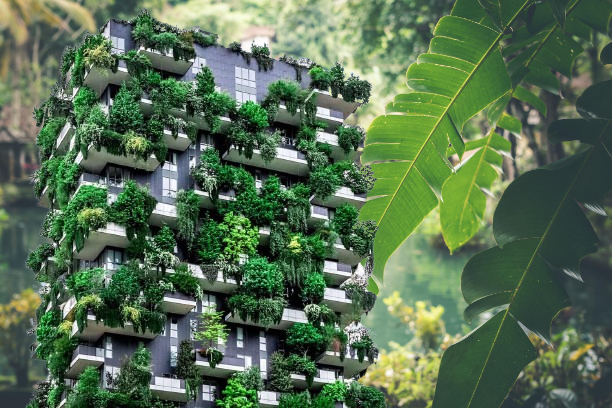LEED vs. BREEAM: Comparing Green Architecture Standards

The phrase “green building” is not unheard of in today’s world, where individuals worldwide are experiencing the effects of climate change and are attempting to lessen its effects by adopting eco-friendly lifestyles. It is likely that you have heard of sustainability and sustainable architecture, even if you are not an architect, builder, or real estate agent. Green building rating systems assess buildings based on how well they use natural resources and how they affect the environment and human health overall.
Two such green building rating systems are BREEAM and LEED.
LEED: What is it?
The United States Green Building Council created LEED, one of the most well-liked green building certification schemes in the world. Leadership in Energy and Environmental Design is what it stands for.
We are all aware of the significant influence buildings have on the environment, our health, and our general well-being. Structures are expensive to maintain and run, consume resources, and produce waste. In order to achieve higher productivity and improved occupant health, green building is the practice of planning, developing, and maintaining structures in a way that minimizes waste and environmental impact, lowers life cycle costs, and uses fewer resources.
An internationally renowned green building certification program called LEED offers third-party confirmation that a specific building or complex was planned and built with consideration for the following factors:
- Highest possible energy savings
- Water use efficiency Lower greenhouse gas emissions
- Improved indoor air quality
- Greater utilization of recycled materials
- Best use of available resources while being mindful of their effects
- Lower costs for upkeep and operation
BREEAM: What is it?
BREEAM, an acronym for Building Research Establishment Environmental Assessment Method, was established nearly thirty years ago in the United Kingdom by the Building Research Establishment (BRE) in 1990. It is one of the most well-known and widely accepted green building grading systems in the world, setting guidelines and assessing the environmental impact of both new and old construction.
Stated differently, BREEAM is the most widely used sustainability assessment technique in the world for master planning, infrastructure, and buildings. Throughout the built environment lifecycle, from new construction to in-use to renovation and refurbishment, it acknowledges and reflects the value in higher performing assets.
BREEAM achieves this by employing BRE-developed standards to certify an asset’s evaluation of its environmental, social, and economic sustainability performance by a third party. In other words, BREEAM-rated projects are more environmentally friendly, improve the quality of life for those who live and work there, contribute to the preservation of the environment, and are more desirable as real estate investments.
The distinction between BREEAM and LEED
As you are already aware, BREEAM is an English green building rating system that was introduced by the Building Research Establishment (BRE) in the United Kingdom, whereas LEED is an American system created by the U.S. Green Building Council.
Merely eight years following the development of the BREEAM system, the first LEED building debuted in 1998. These two systems are nearly 70–80% similar technically. In the design, construction, and operation of buildings, they are always evolving and adopting the best practices from around the globe. However, the method used for building certification is very different.
When it comes to LEED, the project team is in charge of the building’s design and construction and typically works with a LEED Accredited Professional to assist them. The team can register the project, prepare the required documentation, and take into consideration the requirements of LEED standards. It compiles all of the project documentation into a package and submits it to the USGBC for section-by-section inspection. A certificate with a specific level is produced if everything is in order.
Although there are some technical criteria similarities between LEED and BREEAM, the processes are very different. A single appraiser, not a team of experts, reviews a project after it is developed (often with the help of a BREEAM consultant). This is known as the “appraiser” concept in BREEAM. The evaluator follows a very formal procedure: he receives documents that need to be verified to ensure they meet the specified criteria, and he approves them if everything is in order. The appraiser makes two appearances: once during the design phase and once more during the implementation of the object. He drafts a report based on the compliance check findings, which is subsequently forwarded to the UK for a targeted audit. A certificate is the outcome of the evaluation.
It is significant to note that the LEED certificate is only issued once the object is finished, whereas the BREEAM system issues certificates twice—once for the project and once at its completion.
One other significant distinction between the two systems is that BREEAM uses quantitative standards, while LEED bases its thresholds on percentages.
The subtlety of the LEED system is that, in order for the building to be classified as green, it must adhere to a set of extremely strict mandatory requirements. But as a system, BREEAM is more adaptable. While there are requirements, they are far less complicated than LEED. According to BREEAM, the requirements increase with certification level. One of the requirements, for instance, is that the fluorescent lights be high-frequency and flicker-free. Since none of the modern equipment flickers, this is very simple. The system is generally more adaptable; while the building may not be made extremely energy-efficient, it may be improved or furnished with more environmentally friendly materials or with better air quality. You can still obtain a certificate by meeting alternative requirements, but the degree of certification is limited.
Geographically speaking, LEED makes more sense for a global corporative policy while BREEAM is more common in the United Kingdom. Because LEED is used in more countries, it is therefore the most well-known certification; however, in Europe, BREEAM is preferred for certified buildings.
Which is preferable, BREEAM or LEED?
It is necessary for both certifications to refine their perception of whether a high rating results in better operational performance for construction projects. Both of them give the building a rating without taking into account how the building actually functions.
BREEAM and LEED are measurement tools; they do not excuse subpar design work. The design process ought to lead the way and show which certification scheme is most effective in a given circumstance.
Because BREEAM is more widely used and more affordably implemented in the UK, it is more suited to the country’s laws and standards than LEED. Nevertheless, compared to BREEAM, LEED is becoming more and more recognized worldwide.
Procedure for LEED Certification
Four primary steps are involved in LEED certification:
1. Register – After filling out the necessary paperwork and paying, register your project. Make sure your project satisfies all requirements set forth by the LEED Minimum Program. In order to be certified LEED 2009, building projects need to:
- Observe environmental regulations
- Be a finished, long-lasting structure
- Make use of a sensible site perimeter.
- Respect the minimum floor area specifications.
- Respect the minimum occupancy requirements.
- Agree to provide data on water and energy consumption for the entire building.
- Respect a minimum ratio of building area to site area.
Arc and LEED Online are the two online portals where registration is available. Choose the appropriate portal for your project’s registration and LEED certification pursuit.
2. Application – After registering your project, you must gather and send in the necessary supporting materials so that GBCI can examine it. You will designate LEED credits that you wish to pursue to project team members in collaboration with them. Subsequently, the team members will gather data, conduct computations and evaluations, and draft records attesting to your fulfillment of the requirements and your chosen credits.
When your application is ready, upload the finished materials and make sure to thoroughly review the entire document before submitting it for review.
Remember to pay the review fee for your certification!
3. Review – Green Business Certification Inc. (GBCI) carefully examines your LEED application after you have filed it and paid the certification fee. Within 20 to 25 business days, GBCI will reply with its preliminary review, indicating which prerequisites and credits are granted and which are listed as pending. It will also include a request for additional information.
If you are happy with the preliminary review results, you can submit them for final review, or you can prepare new or revised documentation or try for more credits.
Following the completion of your final application review, your project team has the option to accept, dispute, or request an additional supplemental review from GBCI.
4. Certify – Receiving the final certification report is, of course, the last but most important step. Getting that seal of approval for your efforts to operate as a greener building is well worth the lengthy and intimidating process.
It should be noted that there are four LEED certification levels: Certified, Gold, Platinum, and Silver. No matter what certification level is attained, all projects must fulfill the required prerequisites listed below:
- Area of Priority
- Design Innovation Awareness and Education
- Sustainable Sites for Transportation and Location
- Resources and Materials for Energy
- Costs associated with operating and maintaining indoor environmental quality
Basic LEED certification is obtained with 26–32 points, silver-level certification is obtained with 33–38 points, gold-level certification is obtained with 39–51 points, and platinum certification is obtained with 52 points or more.
The BREEAM Certification Procedure
The following steps are involved in the BREEAM certification process:
- Selecting which BREEAM standard best fits your development would be the first step.
- After that, you must designate a certified BREEAM Assessor to evaluate your building or project in accordance with the appropriate BREEAM standard.
- The following action would be to register your project with the licensed BREEAM Assessor you have been assigned for assessment.
- The next step is to conduct a pre-assessment using your licensed assessor’s experience and knowledge as assistance.
- As the project and evaluation advance, gather the required project data and forward it to your assessor.
- After reviewing the data, your certified assessor will decide whether or not the information complies with the standard.
- After that, your certified assessor will send their evaluation for approval to the certifying authority.
- Finally, get your BREEAM certificate listed and display your accomplishment with a case study, BREEAM banner, or plaque from the BREEAM online store.
The total of the weighted category scores determines the building’s final performance rating after it has been thoroughly evaluated. A rating on a BREEAM certification level scale is derived from the total score, which is as follows: Unclassified (<30%), Pass (>30%), Good (>45%), Very Good (>55%), Excellent (>70%), and Outstanding (>85%).
Please be aware that performance that does not comply with BREEAM is indicated by an unclassified BREEAM rating. This could be the result of failing to achieve the overall threshold score needed for official BREEAM certification, or failing to meet the BREEAM mandatory standards of performance for important sustainability issues. Assessments that are not classified will not receive a certificate.

